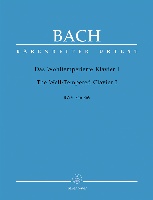Ich glaube, lieber Herr, hilf meinem Unglauben (I
believe, dear Lord, help my unbelief), BWV 109, is a
church cantata by Johann Sebastian Bach. He composed it
in Leipzig for the 21st Sunday after Trinity and first
performed it on 17 October 1723.
Bach wrote the cantata in 1723 during his first year in
Leipzig for the 21st Sunday after Trinity. The
prescribed readings for the Sunday were from Paul's
Epistle to the Ephesians, "take unto you the whole
armour of God" (Ephesians 6:10–17), ...(+)
Ich glaube, lieber Herr, hilf meinem Unglauben (I
believe, dear Lord, help my unbelief), BWV 109, is a
church cantata by Johann Sebastian Bach. He composed it
in Leipzig for the 21st Sunday after Trinity and first
performed it on 17 October 1723.
Bach wrote the cantata in 1723 during his first year in
Leipzig for the 21st Sunday after Trinity. The
prescribed readings for the Sunday were from Paul's
Epistle to the Ephesians, "take unto you the whole
armour of God" (Ephesians 6:10–17), and from the
Gospel of John, the healing of the nobleman's son (John
4:46–54). The unknown poet of the cantata text
stressed the faith, which made the healing possible.
The cantata opens with a quote from the Gospel of Mark,
The possessed boy, Mark's rendition of the gospel (Mark
9:24). The following movements almost form a dialogue
between fear and hope, or belief and doubt, such as
Bach would compose three weeks later in O Ewigkeit, du
Donnerwort, BWV 60, and again for Easter of 1724 in
Erfreut euch, ihr Herzen, BWV 66. Movement 2 is a
dialogue, movement 3 the expression of fear, movements
4 and 5 turn to hope. The closing chorale is verse 7 of
"Durch Adams Fall ist ganz verderbt" of Lazarus
Spengler (1524).
The opening chorus shows many elements of a concerto
grosso. In the instrumental ritornello, oboe 1 and
violin 1 form the concertino. The vocal parts appear
sometimes as a solo or duet, expressing belief in an
upward theme derived from the ritornello theme, with
doubt expressed in a downward line.
The inner dialogue in movement 2 is marked forte and
piano, rather than giving the words to two different
singers, as John Eliot Gardiner points out: "Bach
reinforces the dichotomy between faith and doubt by
assigning two opposing voices sung by the same singer,
one marked forte, the other piano, alternating phrase
by phrase and surely unique in Bach's recitatives". The
final question "Ach Herr, wie lange?" (Ah, Lord, how
long?) is intensified as an arioso, marked adagio. In
the following aria fear is expressed, according to
Gardiner, in "jagged melodic shapes, unstable harmonies
headed towards anguished second inversion chords, and
persistent dotted rhythmic figures". It has been
compared to the tenor aria from Bach's St John Passion,
Ach, mein Sinn.
The closing chorale is not a four-part setting, but a
complex chorale fantasia with an independent orchestral
part, in which the choral part is embedded. The lines
of the chorale melody "Durch Adams Fall ist ganz
verderbt", interspersed by interludes, are sung in long
notes by the soprano (with the corno) on a foundation
of faster movement in the lower voices. This movement
is the first chorale fantasia written in a Bach cantata
in Leipzig, to be followed by many such movements
opening chorale cantatas of the second annual
cycle.
Although originally scored for alto and tenor soloists,
a four-part choir, cor du chasse (corno da caccia or
corno da tirarsi), two oboes, two violins, viola, and
basso continuo, I created this arrangement for Winds
(Bb Trumpet, 2 Oboes & Strings (2 Violins, Viola &
Cello) and Concert (Pedal) Harp.






 Faire un don
Faire un don